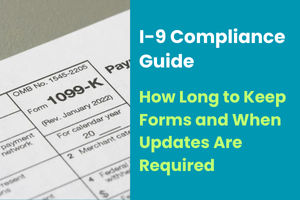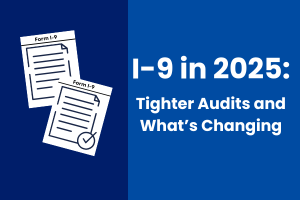Understanding Form I-9 and Its Role in Compliance
For every employer in the United States, maintaining compliance with immigration laws begins with one crucial document: Form I-9 (Employment Eligibility Verification). This form confirms both the identity and work authorization of every individual hired—regardless of whether they are U.S. citizens or non-citizens.
Employers must:
- Have new hires complete Section 1 no later than their first day of work.
- Complete Section 2 within three business days of the employee’s start date.
- Use Section 3 when re-verifying expiring work authorization or recording a rehire.
Failure to manage this correctly can expose employers to audits, penalties, and reputational damage.
How Long Do Employers Need to Keep I-9 Forms?
Unlike other HR records, Form I-9s must be retained for a specific period. Employers must follow a precise retention rule:
- Three years from the date of hire, or
- One year after the employee leaves the company
Whichever date is later.
Example:
- Employee hired: July 1, 2020
- Employee terminated: July 1, 2022
- Three years from hire = July 1, 2023
- One year after termination = July 1, 2023
Retention deadline: July 1, 2023
Keeping expired records longer than required increases liability. On the other hand, disposing of them too soon risks non-compliance during an ICE audit.
Do I-9 Forms Need to Be Updated?
In most cases, once completed properly, Form I-9 doesn’t require ongoing updates. However, there are three key exceptions:
- Reverification
- If an employee’s work authorization expires (e.g., temporary visa holders), employers must reverify before the expiration date using Section 3.
- U.S. citizens and permanent residents are exempt since their work eligibility never expires.
- Rehire
- If an employee returns within three years of their initial hire, you can either:
- Use the existing I-9 and update Section 3 with the new hire date, or
- Complete a brand-new I-9 form.
- If an employee returns within three years of their initial hire, you can either:
- Name Changes
- Employers are not legally required to update I-9s for employee name changes.
- Still, it’s considered a best practice to document such changes for internal accuracy.
Best Practices for Staying I-9 Compliant
- Secure storage: Keep I-9s separate from personnel files in locked cabinets or encrypted systems.
- Track expirations: Use reminders or HR software to monitor expiring work authorizations.
- Purge old records: Regularly destroy I-9s past the retention date.
- Be audit-ready: ICE can request records with as little as three days’ notice.
Penalties for Non-Compliance
Improper handling of Form I-9 can lead to costly consequences:
- Civil fines – $272 to $2,701 per form error (2025 rates)
- Criminal charges – for knowingly hiring unauthorized workers
- Business license suspension – in states with stricter penalties
These risks underscore the importance of I-9 compliance for HR and payroll teams.
Final Takeaway
Managing I-9 forms goes beyond basic paperwork—it’s about protecting your organization from legal, financial, and operational risks. By knowing exactly how long to keep I-9 forms and when updates are required, employers can build a strong compliance foundation, avoid penalties, and show due diligence in their hiring process.


